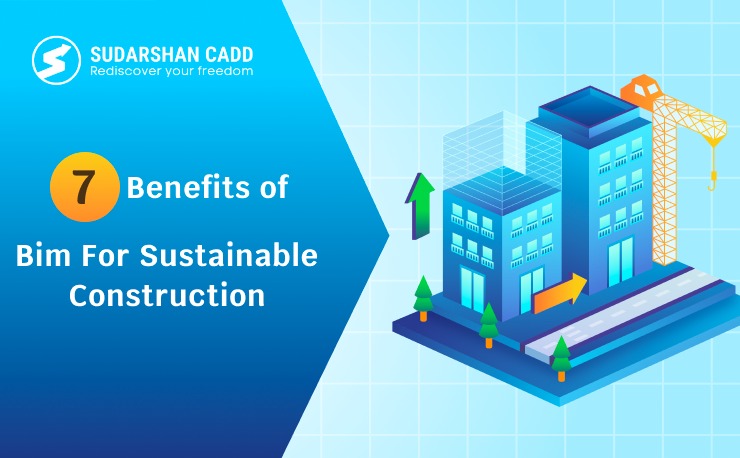
7 Benefits of Bim For Sustainable Construction
Sustainability has become a paramount concern in modern construction practices. Building Information Modeling (BIM) has emerged as a crucial tool in achieving sustainable construction goals by integrating data, processes, and stakeholders throughout the project lifecycle. This guide explores the key benefits of using BIM for Sustainable Construction and why it is essential in today’s industry.
What is Sustainable Construction?
Sustainable construction refers to the design, construction, operation, and maintenance of buildings and infrastructure that minimizes environmental impact, conserves resources, promotes energy efficiency, and enhances overall social and economic well-being.
Why is Sustainable Construction With BIM Crucial?
BIM plays a pivotal role in sustainable construction by enabling comprehensive planning, analysis, and optimization of building projects. It facilitates collaboration among architects, engineers, contractors, and owners, leading to more informed decisions that prioritize sustainability metrics.
Top 7 Benefits of BIM for Sustainable Construction
Optimized Design
BIM allows for the creation of detailed 3D models that incorporate sustainable design principles such as passive heating and cooling, daylight harvesting, and efficient space utilization. Design optimization leads to reduced energy consumption and operational costs over the building’s lifespan.
Energy Performance Analysis
BIM software integrates energy analysis tools that simulate the building’s energy performance under various conditions. This helps identify opportunities for energy savings, select sustainable materials, and meet green building certification requirements.
Waste Reduction
BIM facilitates waste reduction through accurate material quantity takeoffs, prefabrication planning, and construction sequencing. By minimizing waste generation and improving resource efficiency, it promotes sustainable construction practices.
Lifecycle Management
BIM supports a building’s entire lifecycle, from design and construction to operation and maintenance. It enables the tracking of building performance metrics, maintenance schedules, and retrofitting strategies to enhance sustainability throughout the building’s lifespan.
Collaborative Workflows
BIM fosters collaboration and communication among project stakeholders, including architects, engineers, contractors, and facility managers. This collaborative approach ensures that sustainability goals are integrated into every phase of the project and maintained post-construction.
Regulatory Compliance
BIM platforms provide tools to streamline compliance with environmental regulations, building codes, and sustainability standards. By automating compliance checks and documentation, projects can achieve higher levels of sustainability certification.
Data-Driven Decision Making
BIM generates valuable data insights that inform decisions regarding sustainability strategies, performance monitoring, and retrofitting initiatives. Data analytics help optimize building operations, reduce carbon footprint, and enhance occupant comfort and well-being.
What is the Purpose of Sustainable Construction with BIM?
Integrating BIM into sustainable construction practices aims to create buildings and infrastructure that are environmentally responsible, resource-efficient, cost-effective, and conducive to occupants’ high quality of life. BIM enables the realization of sustainable design goals through holistic project management and data-driven strategies.
Read More: Autocad Vs Revit
Where is Sustainable Development Currently Being Used, and How?
Commercial Buildings
Sustainable development principles are widely applied in the construction and operation of commercial buildings. This includes incorporating energy-efficient systems, using sustainable materials, implementing waste reduction strategies, and promoting green spaces.
Residential Complexes
Residential complexes are increasingly adopting sustainable development practices. This involves designing eco-friendly buildings, integrating renewable energy sources like solar panels, implementing water conservation measures, and creating community recycling programs.
Educational Institutions
Educational institutions are integrating sustainable development into their campuses. They focus on energy conservation through efficient lighting and HVAC systems, promote sustainability education and awareness among students, implement green transportation options, and utilize sustainable landscaping techniques.
Healthcare Facilities
Healthcare facilities are embracing sustainable development to reduce environmental impacts and improve patient outcomes. This includes using eco-friendly building materials, implementing energy-efficient lighting and equipment, responsibly managing medical waste, and promoting healthy indoor environments.
Infrastructure Projects
Sustainable development principles are key in infrastructure projects such as transportation, water management, and urban planning. This involves designing efficient public transportation systems, implementing stormwater management solutions, incorporating green infrastructure like parks and green roofs, and considering climate resilience in infrastructure design.
How Can Sudarshan CADD Help You With BIM For Sustainable Construction
Sudarshan CADD offers specialized training, consultancy, and implementation services to empower construction professionals to leverage BIM for sustainable development.
From sustainable design strategies to energy analysis and green building certification support, Sudarshan CADD provides the expertise and tools necessary to achieve sustainability goals effectively from Scan to CAD, scan to BIM, and more.
Conclusion
BIM catalyzes the advancement of sustainable construction practices by integrating environmental considerations, resource optimization, and stakeholder collaboration into every phase of the project. The benefits of using BIM for sustainable construction are far-reaching, leading to greener buildings, reduced environmental impact, and enhanced long-term value for communities and stakeholders.
FAQ
What is the role of BIM in green building?
BIM enables the integration of sustainability into design, construction, and operation by analyzing energy use, materials, waste, and environmental impact of eco-friendly buildings.
Which dimension of BIM is associated with sustainability?
5D BIM, focused on cost management, also includes sustainability factors like energy efficiency and lifecycle costs.
What is 6D BIM sustainability?
6D BIM integrates environmental data for carbon footprint analysis, energy predictions, and lifecycle assessments, aiding decisions for sustainable building practices.

